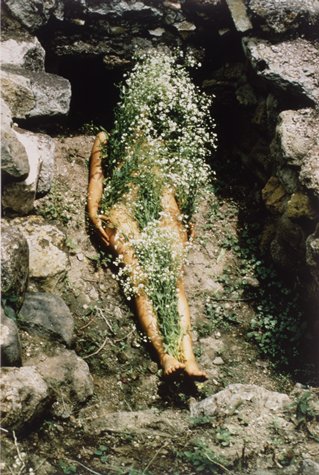FEMALE STUDY: ANA MENDIETA
Whenever I go into design mode, I think about gender bending and unisex or un-gendered fashion, which always takes me on a fun ride. While rifling through moodboards, I began studying the work of Ana Mendieta, the late artist whose work with the female body in the 70s and 80s forged the way for women in the contemporary art world.
Aside from a few images, I knew very little about Mendieta before my study, as I mostly encountered her work on tumblr. But Mendieta's story is actually quite compelling, and I now consider her a significant part of American art history.
Mendieta came to the US as a refugee from Cuba at age 14 with her sister. She lived in refugee camps her first few weeks in the US before being placed in foster care in Iowa, where she eventually went to art school before working in Mexico and New York City. At this time, identity was a big topic of discussion, and working with blood had become a medium exclusive to the feminist artist. Mendieta applied both mediums as a means to convey somewhat autobiographical performance works she called "earth-body" work.
Her early pieces made in Mexico, Silueta, included explorations with body art and land art, where the female body was used almost as a corpse that became part of the landscape.
Upon her return to the States, she produced, Chicken Piece, in reaction to the rape of a student at the University of Iowa, where she covered herself in feathers, using blood and a decapitated chicken.
Then in 1982 she performed works she called, Body Tracks, where she used her body as a stamp and blood as the ink
I really love how blood was used as a sign of femininity in her work.
But just as her reputation was growing momentum, Mendieta fell to her death in 1985. This topic is pretty controversial because it was during a drunken argument with her husband (artist, Carl Andre) and it is unclear how Mendieta fell out the window of their 33rd floor apartment. Some speculate that he pushed her out, but the court ruled after a three year trial that she accidentally fell out or perhaps jumped out because there was enough reasonable doubt that Andre didn't kill her.
Seven years after Mendieta's death in 1992, activists holding signs that read, "Where is Ana Mendieta?" blocked the entrance of the Gugenheim Museum's opening show as a means in part, to discuss her enigmatic death, but also to highlight the absence of female artists in high profile exhibitions. It is said that there were more than 500 women present, so I'm not sure why I can't find photos. (I guess mainstream media didn't cover it and people didn't have iphones. And also probably because the stuffy art assholes were bummed about it). But what remains as a legacy is included in a book released in 1999 called, Where is Ana Mendieta?: Identity, Performativity and Exile, by Jane Blocker.
I have yet to read Blocker's book, but as I said, I think Ana Mendieta is an important figure in American art history. Not just as a female, but also as a representative for immigrants exiled to the United States. She played a major role in performance in the 1970s and 80s, experimented with land art, brought blood to the white wall gallery setting and helped voice the feminist movement even after her death.
Bad. Ass.
Courtney Bagtazo, © Bagtazo, 2015










